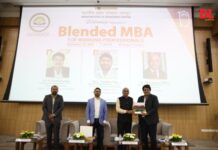 Nishant S. Rajawat
Nishant S. Rajawat
Director (Technology)- APAC, Cybernetyx Interaktiv UG (haftungsbeschr
As Marc Prensky puts it, it, “Our students have hanged radically.Today’s students are nolonger the people our educational system was designed to teach.”It is now clear that as a result of this biquitous environment and the sheer volume of theirinteraction with it, today’s students thinkand process information fundamentally differently from their predecessors. They are Digital Natives, born in the information age, and at ease with it. So what does that make the rest of us? Those of us who were not born into the digital world but have, at some later point in our lives, become fasci- nated by and dopted many or most aspects of the new technology are, and always will be compared to them, Digital Immigrants. Consequently, the digital natives tend to understand better with the digital representation and processing of the available information whereas, the digital immigrants intrinsically only comprehend the physical objects and information and relate the digital nformation with the same for the purpose of understanding. For the digital mmigrants to get comfortable to the newer tools of learning, these tools have to mimic the real world in a convincing way. On the other hand, for the digital atives, the new learning tools have to be a swifter and exciting way to interact ith the vast amount of digital information available to them. Digital nformation is increasing exponentially in the form of images, videos, and data. Cybernetyx also plans to introduce various devices in the Indian market pertaining to etter interface between the students and the enormous amount of digital information available in a rich and a fun way. We are focused on introducing interactive tools which will understand the “human” ways of interaction and which will respond to our ways of communication. Additionally, these tools will be intelligent enough to be capable of interacting with real physical bjects. Children can learn alphabets by taking a physical dummy of the letter and keeping it on the table-top interface. The interface will not only identify the object and its genre but also will react by triggering a set of relevant events ncluding various ways of writing and pronouncing the alphabet. The new rameters of the digital interaction will also allow us to move beyond the single-input driven WIMP interface, and the newer set of devices will allow us to interact with the interface using our gestures and physical movements. One important skillset that will be required to succeed in the advent of the information age is bound-less collaboration. This essential skill can be boosted by using the collaborative interfaces that the newer devices of interaction will provide us. These interfaces will not only entice and excite the kids to learn the essential skills of collaboration, but also how to use it for meaningful creation. The results of these acquired skillsets will go a long way into their ives, as thedigital information will only increase exponentially in the coming times.
























